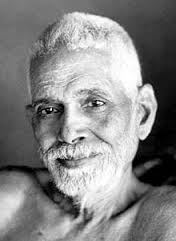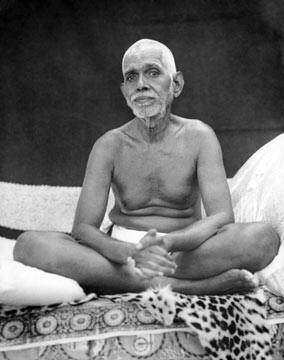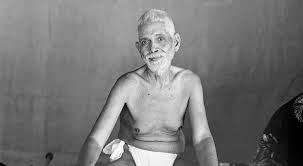
Most of the time, Bhagavan remained in silence. Sometime, he did not give reply and sometime he gave reply after few days, but at all times he gave the reply in short and in few words. Sri Venkataramiah who moved very closely with Bhagavan noted the brief reply Bhagavan gave and published them in detail in “Talks with Bhagavan”. The replies which Bhagavan gave came like sparks but they were enlightening and illuminating. Here, we take a look at some of the replies Bhagavan gave which were gathered from various books and discourses.
An American lady came to India in search of truth. A sage pointed out to her what Adi Sankara said: “The world is a myth, Brahman alone is truth”. She said she knows nothing about Brahman, but she knows about the beautiful world that appears before her. “How can the world be wrong when I see it distinctly with my eyes and perceive its movement through my intellect? Are the relations I maintain with my family members wrong? Are the economic, political and administrative activities that regulate the world wrong?” She pondered. She then came to Ramanasramam and raised her doubts to Bhagavan. Bhagavan asked her: “When you were asleep, where was your ‘real world’? Could you perceive it at that time? You saw certain images during the dream and you see certain images during the waking state. Which is real? Did your relatives stood by you while you were dreaming? In fact, the images of the world that you see in the waking state are as unreal as the images you see in the dream state. Know yourself first before you know about the world. What you see is the reflection of the images created by your own mind. What is real is you, the seer and not the seen.” Gradually, the truth dawned on her. It was wrong to find reality in a world that appears and disappears. It was wrong to find spiritual fulfillment by being in the materialist world. She therefore decided to seek the Self-knowledge (Atma Jnana) by being away from the world of materialism and by being her true Self.
Two Parsi ladies came to the Ashram and posed the question: “My knowledge is theoretical and not practical. How shall I gain practical realization of the Self?” Bhagavan replied: “Realization is nothing to be gained afresh. It is already there. It is your nature. There is never a moment when the Self is not. It is ever-present, here and now. If it is not there or if it is something new to be attained afresh, it is not worth pursuing, because, what is got afresh will also be lost. So long there is doubt of non-realization; attempt must be made to rid oneself of these thoughts. The thoughts are due to identification of the Self with the non-self. When the non-self disappears, the Self alone remains. To make room anywhere it is enough that things are first moved from there. If only the bundle is removed from the shelf, a space is created there. So what is necessary is to remove the thoughts “I am not realized”. Bhagavan said that ‘present’ alone is real. To investigate the past and future without knowing the truth of the present is like counting without the first and prime number of one. (Nidamum mannum….Ulladu Narpadu 15). A devotee asked Bhagavan: “How can I find out what I was in my previous life?” Bhagavan replied: “Before investigating previous lives, why don’t you inquire whether your present birth itself is real?”
A devotee asked: “How does a grihasta (householder) fare in the scheme of liberation?” Bhagavan replied” “Why do you think you are a grihasta? If you go out as a saint, the thought of being saint would always dominate you. Whether you continue in the household or adopt sainthood, what matters is your mind. Ego is the source of thoughts. It creates the impression that you are a grihasta (householder) or a sanyasi. What is needed is not the substitution of the role of grihasta with sanyasi (saint) but the removal of all identifications. What is needed is not any change in environment but change in the mindset. Another devotee came to Bhagavan and raised the similar question: “Swamiji, I want to find peace and fulfillment in life. Can I go to the forest and do penance (tapas)? Bhagavan replied: “You may go to some holy places, a solitary place or a forest. But wherever you go, chances are, you may be carrying the same mind, the same Vasanas (mental inclinations), the same karmas and the same ego. What needs to be done is Self-examination from wherever you are. Self-examination or Atma Vichara paves way for Self-realization. For Atma Vichara, which is self-initiating and self-sufficient exercise, it is not important where you go but how deep you go within yourself. You may do the Vichara from home or from forest and what is important is the quest to know the Self.”
Once, Devaraja Mudaliar said that one needs the grace of God to be able to get Moksha (liberation). Bhagavan replied: “The grace is already there and you may receive it in abundance so you long you (your ego) do not come in between.” “How to cope up with problems that are mounting day by day?” asked another person. “There is no problem as such”, Bhagavan said “Actually, you are the problem. Though you are the divine supreme, the limitless Self, you confine yourself within the mind. When you identify yourself with mind, you become the problem”. Bhagavan was Jnana personified; one who has answers to all questions that concerned humanity. That is why he was described as saint among saints.
“Bhagavan, how can I keep my body free from disease?” This was the question posed by another devotee. The reply came instantly from Bhagavan: “The body itself is a disease.” When afflicted by a disease, a person cannot pay attention to anything else. Similarly, a person who identifies himself with the body cannot pay attention to anything other than body and therefore the body becomes the disease. A devotee went into a cave near Arunachala Hill and done intense tapas without taking normal food. He gradually reduced the intake till at last he subsisted with barely a mouthful of food. After completing his penance and tapas, he went to Maharshi and said, “Bhagavan, I have found that I could keep the body alive with only a mouthful of feeding a day.” Bhagavan smiled and remarked: “You can be alive even without the body. Bodyless-ness is your real nature. The Self is bodyless-ness (asariram.)” The disciple became speechless by the power of those words.
“All books say that the guidance of a Guru is necessary. Is it so?” asked a devotee. Bhagavan said: “The Guru will not give you anything you do not have already. Even if he gets any such thing, it will go as it came because what comes afresh will also go. What always is will alone remain. Removal of the notion that we have not realized the Self is all that is required. We are always the Self. Only, we don’t realize it.”
A devotee came to Bhagavan and said: “I realize the importance and value of Self-Awareness but I am caught under the net of samsara (family life). I am unable to come out of my attachments towards my own people. Can I renounce everything that belonged to me?” Just one short reply came from Bhagavan that spoke a volume. He said: “The Self has already renounced”. It is only when we cling on to our mind; the possessive spirit takes over us. In almost another similar context, Bhagavan said: “Renunciation is not discarding of externals but the cancellation of the uprising of the ego. You should renounce not just the possessions but the possessor too.” When Sri Muruganar, the ardent disciple, sought Bhagavan’s blessing for Self-realization, Bhagavan’s brief reply was: “Irunda padikke iru” – “Be as you are”. When Muruganar asked; “How one should conduct himself in dealing with the world”. Bhagavan replied: “Iraivan Arul seluttum vazhikke sel” – “Move as the grace of God leads you”. These two sentences sum up the entire teachings of Vedas.
Sri T.K. Sundaresan, an ardent disciple of Bhagavan, used to go up the hill regularly and spend time with Sri Bhagavan. He used to carry a small sugar candy or some eatables as offering to Sri Bhagavan. One day, being short of money, he had to visit Bhagavan bare-handed. On seeing his face, Bhagavan enquired the cause of his dejection. Sundaresan said that he has not brought anything. Bhagavan looked at his face and said: “But you have brought the main thing. You have brought yourself. The most precious thing in the world is “YOU” — the `You’ in every one of us is the truth. You are the main thing. All else is unimportant”. This recalls another instance where the importance of the word ‘YOU” is stressed. Once, a Professor of Philosophy, after listening to the explanation of Bhagavan on the “Forty Verses on Reality” (Ulladu Narpadu) became very emotional and said: “Bhagavan, you are the Greatest Teacher. What you conveyed is the Great Teaching”. Then Bhagavan said: “Teacher and Teaching; for whom? The Greatest Teacher is there and the Greatest Teaching is also there and yet there is a “missing link” in this Golden Spiritual Chain. The missing link is “YOU”. When the Teacher and the Teaching are linked with ‘you’, it becomes the `Golden Spiritual Chain’. Bhagavan is helping the “YOU” in every one of us to wake up and complete the precious “Eternal Chain”. Let us make full use of it, in our daily life. Sri Bhagavan commands us to wake up to Spiritual Perfection. Let us all abide by the Master’s Words of Wisdom”, said the Professor.
On another occasion, Sri Sundaresan asked Bhagavan: “What is that one thing, knowing which all doubts would be cleared?” Bhagavan replied: “Know the doubter. If the doubter is known, doubts will not arise”. Recognize for certain that all are Jnanis and all are realized beings. Only few are aware of this fact. Therefore, doubts arise. Doubts must be uprooted. This means that the doubter must be uprooted. When the doubter ceases to exist, no doubt will rise. Another devotee who came to Bhagavan posed the question: “I wish to help the world. Shall I not be helpful”? Bhagavan said: “Yes, by helping yourself, you help the world. You are in the world. You are the world. You are not different from the world, nor is the world different from you.”
Suri Nagamma was a great devotee of Bhagavan. One day, when she came to Ramanasram, she found Bhagavan seated on the cot. She then started circumambulating (Pradakshina) Bhagavan with veneration. Bhagavan said: “If you do this, others would also start doing it without knowing the significance of Pradakshina. The true Pradakshina is Atma Pradakshina, circumambulating on the Self itself. It means; “I am the Atma and many objects keep moving around me. So, you do the Pradakshina to yourself”. A devotee from Andhra, a good singer, came to Bhagavan and asked whether one can attain liberation by the exclusive means of devotional songs or whether any other Sadhana is required. Musicians like Saint Thyagaraja attained liberation only by singing the glory of God,” she added. Bhagavan replied “They have not attained realization by singing; they have expressed through songs what they already realized and that is why their songs are immortal”.
There was a devotee who came from a poor background and all he knew was simple devotion towards Bhagavan. While other devotees were asking different questions to Bhagavan, this devotee used to simply watch as he thought he was not well-versed in spiritual matters. He heard Bhagavan saying that whatever the devotee does; Vedanta studies, Dhyana, Yoga are aimed at attaining Self Realization at the end. This devotee who could not comprehend the doctrine of Advaita Vedanta merely witnessed the discussion taking place and moved away. One day, when Bhagavan was making his morning stroll on the mountain, this devotee came from the opposite direction. He carried with him a mango fruit to be offered to Bhagavan in case he was lucky enough to meet Bhagavan. Exactly, as he envisaged, he was happy to see Bhagavan and gave the fruit to Bhagavan. Though Bhagavan accepted the fruit, he gave it back to the devotee. The devotee took it as the Prasad or blessings from Bhagavan. Having got the opportunity to meet Bhagavan at close quarters, he expressed his feelings. “The other day while you were deliberating the theories of Dvaita, Advaita and Visishtadvaita, I was there but I could not grasp them. Can an ignorant person like me aspire for the high state of knowledge that you symbolize?” Bhagavan assuaged his feelings and reassured him that he is more qualified to reach the state of Jnana because he is beyond the influence of the opposites like knowledge and ignorance. Bhagavan then explained to him about the theories. “Dvaita means dual. You are there and apart from you the fruit is also there. This is Dvaita. When you put a slice of mango into your mouth, the fruit is in you. Then, both you and fruit, though different, appear as one. This is Visishtadvaita. When you take the fruit completely and the fruit get fully digested, you and the fruit become one. This is Advaita.”
There was a lady devotee who used to visit Ramanasram daily. On an auspicious day, there was special Puja at the Ashram and she was eagerly getting ready to go. At that time, some guests un-expectedly turned up and she had to attend to them. Though she was entertaining the guests, offering them food and talking to them, her mind was hovering around Ramanasram. The next day, when she met Maharshi and explained her delicate situation which forced her to stay at home, Maharshi said: “It is good that you have chosen to remain at home to attend to your guests. If you had come to Ashram, your mind would have been hovering around your home and guests only. You may be physically present here but your mind would have been there only. It was good that you choose to remain at home and thought of Ramanasram rather than visiting Ramansram and thinking of home”.
Even one who has known Bhagavan from very close quarters cannot assume what a reply Bhagavan would give to a question. Even if he assumes some of the possible answers of Bhagavan, when the reply does come from Bhagavan it would be something which he could have never imagined. Once, Sri Devaraja Mudaliar asked Bhagavan: “How it will be when a devotee gets the glimpse of the Self and experience the Brahman within?” Bhagavan replied: It will be like the state of a thief who had been stung by the scorpion while indulging in the theft.”
“What is Nishkamya Karma?”This question was put to Bhagavan by Rangachari, a renowned Pundit hailing from Andhra. Bhagavan did not respond. Though the devotee wondered why Bhagavan has not answered his question, he did not pursue his question. It was time for Bhagavan for his usual stroll towards the mountain along with other devotees and this devotee from Andhra also joined Bhagavan. On the way, Bhagavan saw a long piece of wood with thorns lying on the road. He picked it up, started cutting the edges and shaping the stick. Even while walking and conversing with his followers, he was attending to the stick, trying to smoothen it and straighten it. The disciples observed the extra care with which Maharshi made it into a fine stick. Even while returning, he was seen holding the stick, as if it was some precious possession. As he continued the journey down, he saw a shepherd coming in the opposite direction, called him near and just gave the stick to him. The followers were a little surprised that the stick that Maharshi made with so much care and attention was just passed on to a boy. Maharshi dispensed with the stick as if he has nothing to do with it and forgot about it. Rangachari who was a Pundit and Yogi could get the message loud and clear now. He realized that Bhagavan has answered his question not by means of words but by means of action. A true Karma Yogi does an action very sincerely but without any motivation or desire. He puts his heart into whatever he does but expects no result out of it. He has no likes and dislikes and is beyond the concept of ‘yours’ and ‘mine’. When an action is done dispassionately, without motivation, without the notion of ‘I’, it becomes Nishkamya Karma.

